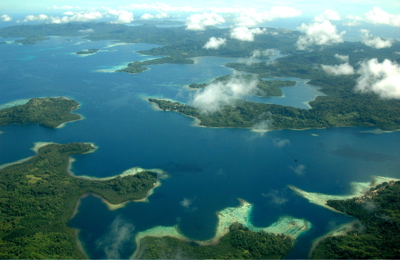|
Collection Point: Solomon Islands
Have you ever considered how well-traveled most of your marine aquarium fish, corals and other invertebrates are? Aquarists are so accustomed to going online or to the local fish store to purchase these remarkable animals that it almost seems like magic. In reality, as this article on obtaining reef species from the Solomon Islands points out, it is far from magic. Getting a marine species from the reef to the aquarist’s tank is a long and complicated process involving many people at every step along the way.
In the case of our currently featured species, the journey begins just northeast of Australia. Comprised of 992 islands, atolls and reefs, the Solomon Islands are known for their remarkable marine life. A virtual paradise, the Solomon Islands have an equatorial, tropical monsoon climate which provides consistent temperatures in the 80s with an average annual rainfall of 120 inches. Dense, mountainous rainforest defines much of the terrestrial environment. On the coast, however, coconut palm-fringed beaches and mangrove forests give way to stunning coral reefs and an impressive array of marine species.

The export of marine species from the Solomon Islands began in earnest in the mid-1990s with an export company called Solomon Islands Marine Export (SIME). A few years later Aquarium Arts Solomon Islands was founded, and today the two companies export the vast majority of these islands’ live animals bound for the aquarium trade. Most fish, corals and other invertebrates are shipped by air from the Solomon Islands to Aquarium Arts United States in Los Angles. From this wholesale facility, the animals are distributed to retailers like Blue Zoo Aquatics.
Fisheries managers in the Solomon Islands are increasingly committed to sustainable development in the live reef fish trade, which includes both fish bound for the aquarium industry and for the restaurant or market. Traditionally, the aquarium fish market in the Solomon Islands is a larger and more profitable market than the live food fish market. There have been some legitimate concerns about the live reef fish trade’s impact on the natural marine ecosystems. The greatest environmental threats related to the live reef fish trade have traditionally been destructive fishing methods such as cyanide use and the collection of particular species in a non-sustainable manner. At present, while some concerns are ongoing, live reef aquarium fish collection in the Solomon Islands is generally being conducted in a manner that is both ethical and sustainable. These improvements are mostly the result of better training and more management control and monitoring of local collectors.
Both SIME and Aquarium Arts purchase their animals from local collectors. More than 100 fish species are commonly collected in the Solomon Islands, including such popular aquarium fish as angels, clownfish, gobies, hogfish, pufferfish, tangs, triggerfish, and wrasses. Collectors earn, on average, anywhere from $3-$5 per fish. Most collection is done by barrier or scoop net on shallow reefs. To be truly sustainable, however, this type of collection requires both training and supplies. As a result of better training and funding, fish mortality as a result of collection has decreased over the past decade, which is better for the environment, the local collectors, the exporters, and the aquarium fish industry in general.
After collection—sometimes taking place in remote areas necessitating a boat ride of several hours—the fish are transported to one of the facilities in Honiara, the capital of the Solomon Islands. Once at the aquarium fish exporters’ facilities, the fish are sorted and then cared for until shipment by air cargo is arranged. Most shipments fly direct from Honiara to Los Angeles, where they arrive at Los Angeles International Airport (LAX). Sometimes they fly from Honiara to Nadi, Fiji to LAX. After arriving in Los Angeles, the fish are held at a wholesale facility before making the trip to a retailer. The process is similar for both coral and invertebrates.
As you can see, it’s a long trip from the Solomon Islands to the United States, and while it is a marvel of passion for the hobby, husbandry and aquarium technology—the fact that these species are readily available is far from magic.
|